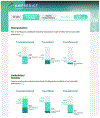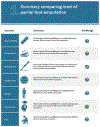Predicting Functional Outcomes Following Dysvascular Lower Limb Amputation: An Evidence Review of Personalizing Patient Outcomes
- PMID: 39389639
- PMCID: PMC11849136
- DOI: 10.1016/j.pmr.2024.06.005
Predicting Functional Outcomes Following Dysvascular Lower Limb Amputation: An Evidence Review of Personalizing Patient Outcomes
Abstract
Most research on people undergoing lower limb amputations for dysvascular disease summarizes average patient outcome risks and average associations between patient factors and these outcomes. More recently, the importance of predicting patient-specific outcomes based on individual factors (ie, personalized rehabilitation) has become evident. This article reviews the evidence and discusses the importance of the following: (1) predicting outcomes to facilitate amputation-level and prosthesis prescription decisions and (2) how prediction models can be leveraged to develop decision support tools to facilitate provider/patient shared decision-making to ensure decisions considering each individual patient's priorities and preferences. Examples of these tools are discussed and referenced.
Keywords: Amputation; Decision support tools; Predicting outcomes; Prosthetics.
Copyright © 2024 Elsevier Inc. All rights reserved.
Conflict of interest statement
Disclosure No authors have any commercial or financial conflicts of interest nor any funding sources to report at the time of this submission.
Figures



Similar articles
-
Determinants of postacute care discharge destination after dysvascular lower limb amputation.PM R. 2011 Apr;3(4):336-44. doi: 10.1016/j.pmrj.2010.12.019. PM R. 2011. PMID: 21497320 Free PMC article.
-
A qualitative study exploring individuals' experiences living with dysvascular lower limb amputation.Disabil Rehabil. 2022 May;44(10):1812-1820. doi: 10.1080/09638288.2020.1803999. Epub 2020 Aug 14. Disabil Rehabil. 2022. PMID: 32795222
-
Comparing Patient and Provider Priorities Around Amputation Level Outcomes Using Multiple Criteria Decision Analysis.Ann Vasc Surg. 2023 Sep;95:169-177. doi: 10.1016/j.avsg.2023.05.026. Epub 2023 May 30. Ann Vasc Surg. 2023. PMID: 37263414 Free PMC article.
-
The experiences and needs of people with dysvascular lower extremity amputations: a qualitative systematic review and meta-synthesis.Disabil Rehabil. 2024 Nov;46(22):5169-5182. doi: 10.1080/09638288.2023.2291552. Epub 2023 Dec 7. Disabil Rehabil. 2024. PMID: 38062867
-
A scoping review of postoperative early rehabilitation programs after dysvascular-related amputations.Prosthet Orthot Int. 2024 Oct 1;48(5):558-564. doi: 10.1097/PXR.0000000000000361. Epub 2024 May 21. Prosthet Orthot Int. 2024. PMID: 38771800
References
-
- Ziegler-Graham K, MacKenzie EJ, Ephraim PL, et al. Estimating the prevalence of limb loss in the United States: 2005 to 2050. Arch Phys Med Rehabil 2008;89(3):422–9. - PubMed
-
- Dillingham TR, Pezzin LE, Shore AD. Reamputation, mortality, and health care costs among persons with dysvascular lower-limb amputations. Arch Phys Med Rehabil 2005;86(3):480–6. - PubMed
-
- Dillingham TR, Pezzin LE, MacKenzie EJ. Limb amputation and limb deficiency: epidemiology and recent trends in the United States. South Med J 2002;95(8):875–83. - PubMed
-
- Heyns A, Jacobs S, Negrini S, et al. Systematic review of clinical practice guidelines for individuals with amputation: Identification of best evidence for rehabilitation to develop the WHO’s package of interventions for rehabilitation. Arch Phys Med Rehabil 2021;102(6):1191–7. - PubMed
-
- Webster JB, Crunkhorn A, Sall J, et al. Clinical practice guidelines for the rehabilitation of lower limb amputation: an update from the Department of Veterans Affairs and Department of defense. Am J Phys Med Rehab 2019;98(9):820–9. - PubMed
Publication types
MeSH terms
Grants and funding
LinkOut - more resources
Full Text Sources

